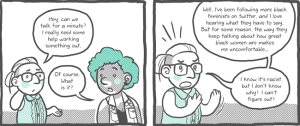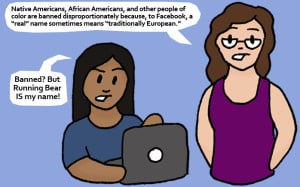
A child with short, curly hair and a ladybug tutu plays on playground equipment.
Originally published on The Body Is Not An Apology and republished here with their permission.
When I was in middle school, I would ask my mom if I could watch certain TV shows other kids were watching: Friends, Scrubs, stuff like that
She said “sure” (she’s pretty chill about stuff like that), but she told me there were a lot of jokes I wouldn’t get.
She was right.
I didn’t understand why the laugh track played when Ross forcibly won’t let his toddler son play with a Barbie, he fires the nanny for being a man, or he and the other men get disgusted at breast milk.
I didn’t understand why JD and Turk’s “guy love” was such a joke, or why entire episodes revolved around stereotypes like women who can’t play sports, promiscuous lesbians, and instances of assault (Paolo, anyone?) taken lightly.
I now recognize that for the most part, when jokes in the media are quote-unquote “adult,” it’s because kids haven’t been indoctrinated with sexism yet.
You aren’t born knowing scripts that men are “supposed” to be disgusting to women, women are “supposed” to be shallow, and god forbid anyone doesn’t conform to the gender binary.
Rewatching those shows now, I see just how heavily they rely on these tropes, how far we’ve come, and how far we have yet to go.
Gender can be thought of as a spectrum. The concept of binary gender is a Western, colonialist construct, and its perceived ubiquity is a tool of oppression and limitation.
Across the globe and throughout history, cultures recognize and respect genders outside the binary, the muxe, the two-spirit, the x-gender, the gender non-conforming, and so on. To be limited by the gender binary is erasure and oppression.
As such, it is crucial to raise a generation who can access these conversations more easily than our predecessors.
We must work to help children think outside the gender binary – to raise them with the language, tools, and mindset to recognize that the binary is incorrect, incomplete, and reductive, that they are permitted to explore across genders, and that trans and gender non-conforming identities are valid.
The gender binary reinforces dangerous stereotypes and reductive roles. It disenfranchises hundreds of thousands of people who don’t identify as one of two genders, participating in their dehumanization and serving as cause for violence and discrimination.
We must advocate for respect, equity, and protection for trans and gender non-conforming people right now, and for future generations.
It’s not easy to confront and combat something so ingrained that it starts from birth – even before birth, as we start gendering at baby showers and the blankets they’re to be wrapped in once they enter the world.
So here are some ways to help kids think outside the gender binary – from their childhood and beyond.
1. Don’t Essentialize Gender
Gender essentialism is the misconception that there are only men and women, and that they are two distinct and fixed identities, with all the trappings of stereotype. It means that in order to be valid, you must conform to certain standards of manhood or womanhood.
Even now, when more and more of us can recognize the cisgender identity as a position of privilege, we still, too, create a binary of cisgender and transgender, erasing non-binary and gender non-conforming identities and perpetuating gender essentialism.
Gender essentialism is toxic – and it manifests from childhood and earlier.
Because of our society, our media, and our culturally reinforced misunderstandings of gender as a binary instead of its true spectrum, we have engrained ideas about what men and women are, what defines them, and what they should be.
Unless you have consciously deconstructed these ideas, you have them too: Men are strong, rational, athletic, capable of few and blunt emotions that are always valid, leaders. Women are weak, over-emotional, fragile, docile, supporters.
This list was nauseating for me to write out, and I hope you rolled your eyes – I hope you know we should be past this.
Not only is gender a spectrum, but people on every designation on that spectrum have the potential for a full range of identities, characteristics, and emotions.
Your gender defines or doesn’t define you as an individual up to a point – from that point forward, you are an amalgam of everything you are, and those traits aren’t inherently gendered. They only have gender imposed on them (more on that next).
However, as obscenely reductive and fallacious as they are, those stereotypes govern our relationships with ourselves and others, as well as institutional and professional decisions.
We must combat gender essentialism, and to do so, we must first recognize it.
You were not born with these ideas. They were taught to you, reinforced by every princess story and adventure tale, by every blue “boys’” aisle filled with constructive toys and workable clothes and every pink “girls’” aisle filled with imaginative toys and decorative or outright objectifying clothes.
Teach your children that people are people. Raise them to see individuals for who they are, not who they are expected to be based on their pronouns.
Don’t assume that your son will grow up to like sports and girls, your daughter to grow up to like clothes and boys, and don’t assume the gender of your child before they’re old enough to determine it for themselves.
Normalize the use of “they” pronouns. Introduce it to your child just as they’re taught “he” and “she.” Normalize the use of “friends,” “guests,” or “everyone,” instead of “boys and girls,” “men and women,” and “ladies and gentlemen.”
Allow the phase “gender is a spectrum” to enter your child’s vocabulary from the moment they learn what “boy” and “girl” mean. Teach them that there are boys, girls, people who are both, and people who are neither.
Teach them that just like how their genitals are private, the genitals of other people is not their business, and one’s genitals have no bearing on their gender identity.
Teach them to advocate for the rights of people who fall within the gender spectrum, just as they’d do for anyone being bullied. Teach them they’re permitted to explore their own gender.
Don’t allow your child to grow up in an environment that encourages casual misogyny or permits toxic masculinity. When a peer, friend, or teacher says something that essentializes gender – arguing that a boy can’t wear a dress, that girls are worse at sports, that girls must like fashion, or boys can’t like boys – don’t let it slide.
Don’t let “jokes” slide. Don’t excuse a boy’s harassment with “boys will be boys.”
Children aren’t born understanding the intricacies of the gender binary – they’re taught. Teach the narrative of a gender spectrum to the children with whom you interact.
Gender essentialism intersects with and manifests through misogyny and toxic masculinity.
2. Don’t Gender Personal Characteristics and Attributes
Don’t color-code children. Pick gender neutral colors from the beginning – reds, greens, yellows, beiges – or just include both pink and blue until they can choose their preferences for themselves.
Let them choose what to wear and what to be.
Capitalism thrives on sexism and the gender binary, gendering everything – foods, fabrics, books, colors, behaviors, attractions – and playing on our culturally constructed insecurities, emphasizing that you need this razor or that diet pill to be a valid woman, this deodorant or that shoe to be a valid man.
I was devastated when I saw the new editions of Roald Dahl books. I grew up loving how they could appeal to any kid, celebrating the weird and sometimes painful aspects of childhood, not shying away from tough subjects – or cool girls.
Now, some of his most popular titles have been brazenly color-coded, and I want to fight this as much as possible. Any kid can love (or be terrified by) Matilda and The BFG!
Point this out to your kids.
Show them that gendered products are essentially the same, and that they’re welcome to use whatever they want, whatever fits them best, or perhaps to support a company that doesn’t exploit the perceived gender binary.
Also, raise your kids to recognize that anyone can be compassionate, clever, strong, or rational. Raise them to approach their emotions, to understand why they feel a certain way. Don’t write off young men as inherently aggressive, young women as inherently weak or spineless.
Raise them to recognize that men’s anger is taken more seriously, to anticipate that women’s anger or pain is dismissed. Take their emotions seriously, no matter what. Ask them why they feel sad or angry, and talk about it. Teach them to be compassionate human beings, to themselves and others.
Don’t participate in the degradation of the feminine. “Gender neutral” doesn’t mean “masculine.”Allow them to celebrate that which is coded feminine in themselves, it’s there, and if it’s not, teach them to respect it.
Misogyny is in ingrained in our society. Too often, raising “strong women” or “strong men” is perceived to mean destroying compassion, communication, and sensitivity. Teach children that these traits are strength and maturity, not weakness.
3. Don’t Gender Toys and Careers
Don’t expect you know what they want because of their gender.
Women are disproportionately discouraged from pursuing careers in STEM fields, and men are still ridiculed (or hyper-praised) for pursuing careers in “domestic” fields.
Fill your child’s walls and shelves with role models across genders and careers. Talk to the children in their life about what they love doing and why.
Western society still sees men as better logicians and businesspeople, woman as caregivers and administrative assistants. Men as constructive, productive thinkers; women as irrational and sensitive.
This is, of course, incorrect, reductive, and sexist – and toys and narratives that we routinely give children perpetuate these harmful ideas.
When we allow ourselves to look beyond the gender binary, and when we help kids think outside the gender binary, we open ourselves up to a society with the potential to be more fulfilling, to allow every person to follow their actual interests and potential.
Give them toys and tools that are both imaginative and constructive: dolls and legos, Little Bits and story books. Teach them to use both, and to value both ways of thinking.
They may end up being better at one or the other, they may end up being well-rounded – either way, the important takeaways are that neither is inherently better, both are important, and anyone of any gender can be better at either, and successful in any career.
4. Teach Diverse History
Don’t let the patriarchy get to them first! Don’t let sexism and gender essentialism shape the way they see the world and themselves.
Give them stories and scripts that open their minds instead of narrowing them. Teach them that there are so, so many ways to be a human being.
Teach them about women doctors, scientists, and politicians. Teach them about gay activists and trans and gender non-conforming role models. Teach them about radical black men, radical Asian men, radical Native men who fought patriarchal injustice. Teach them about Miss Major Griffin-Gracy, Laverne Cox, Harvey Milk, and Angel Haze.
Encourage them to read I Am Jazz, Gracefully Grayson, Beyond Magenta, Lumberjanes, Worm Loves Worm, And Tango Makes Three, The Answer, and George for the earliest starts. Introduce them to Steven Universe, featuring canon non-binary characters!
5. Encourage Identity Exploration
Allow children to be themselves. Allow them to wear suits, dresses, heels, boots. Allow any child to be a princess, a hero, a knight, a firefighter.
Encourage them to experiment and explore, and support their peers to do the same! Make your own clothes and Halloween costumes, or let them shop in any section of the store they prefer.
Encourage the children in your life to recognize, in these little ways, that gender is a spectrum, and that neither perceived gender nor genitals prescribes who a person will become – and it’ll end up being a pretty big shift.
Allow gender neutral and gender-spectrum language to be more familiar and natural than the language of the binary and patriarchy.
Advocate for them. If a child in your life is non-binary, reach out and seek community if you can. No matter who your child is, advocate for the understanding of gender as a spectrum.
And importantly, be a role model.
They’re watching the way you talk about men and women, and the way you include or neglect other a/genders. They’re listening to gendered and gender neutral language. They’re listening to the expectations you have of them, who they’ll grow up to be and love.
Allow them space and possibility beyond the binary.
Seriously, they’ll get it.
When you show kids the possibilities that open up when they’re not trapped by the binary, they’ll start to see the world as a place of far more opportunities. They’ll grow to see people and gendered concepts as they truly are, and start to discover who they really are as a person.
Hopefully, these tips will help individuals of all ages think outside the gender binary.
***
To learn more about this topic, check out:
- Raising A Son In a World of Toxic Masculinity
- On This Edge: Creating Safe Space for Gender-Neutral Youth
- 5 Ways I Teach My Children Intersectional Feminism… And Why It Matters
- A Walking Gender Studies Class: Talking to Children About Transgender Experience
[do_widget id=’text-101′]
Maya Gittelman is a queer, mixed Eastern European Jewish and Pilipinx individual. She was an English major, loves writing, and spends much of her time emoting about intersectional representation in the cultural canon, as well as contemporary media. She is passionate about radical self love, justice, accessibility, radical and intersectional education, and representing issues that matter by highlighting the voices with authority. Follow her on Facebook and Twitter @mayagittelman.
Search our 3000+ articles!
Read our articles about:
Our online racial justice training
Used by hundreds of universities, non-profits, and businesses.
Click to learn more




















